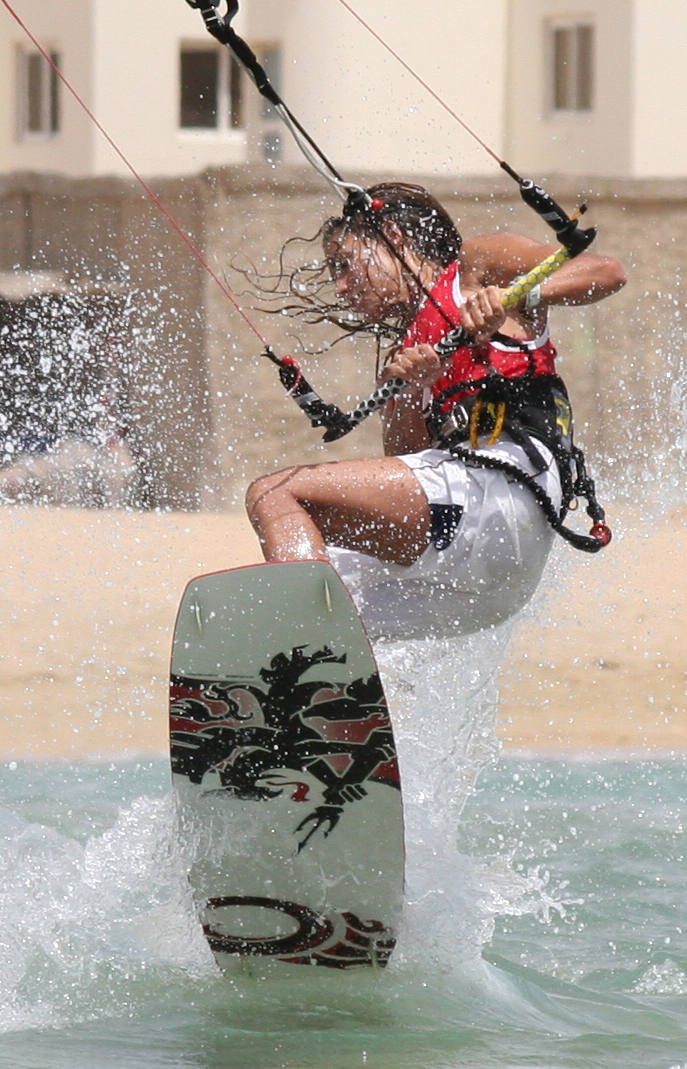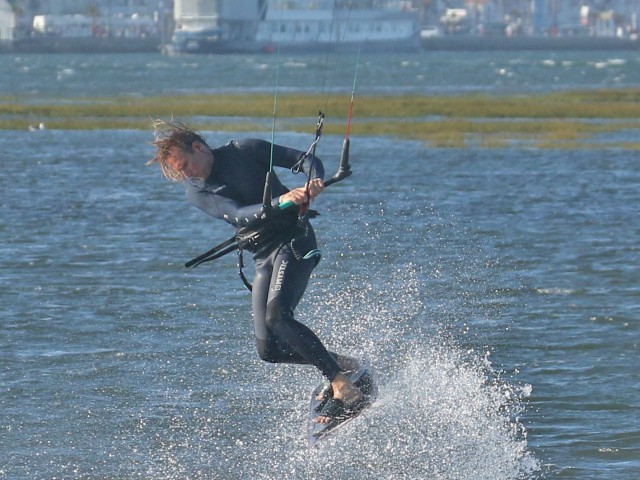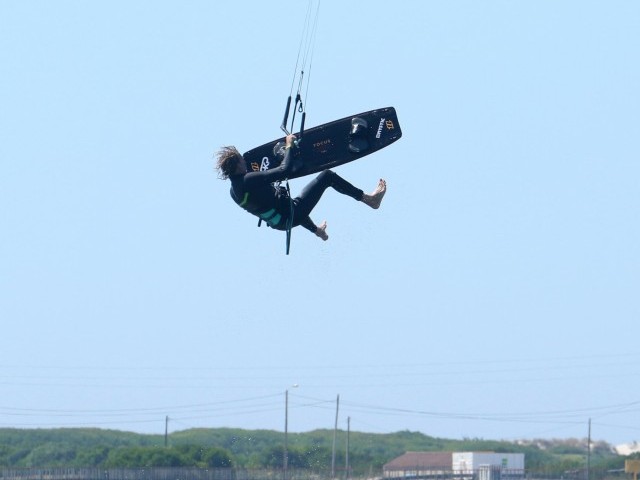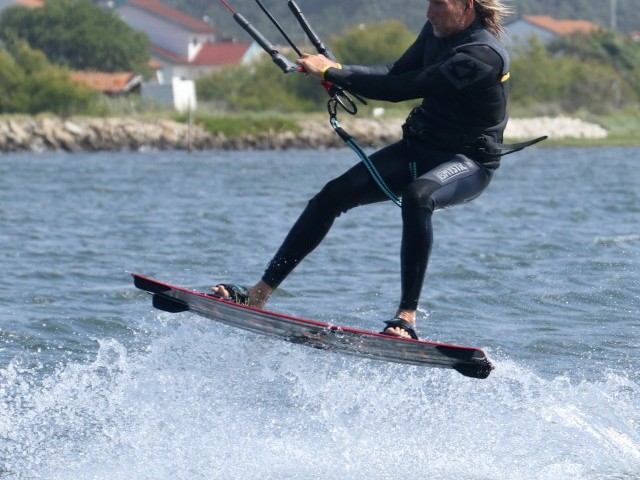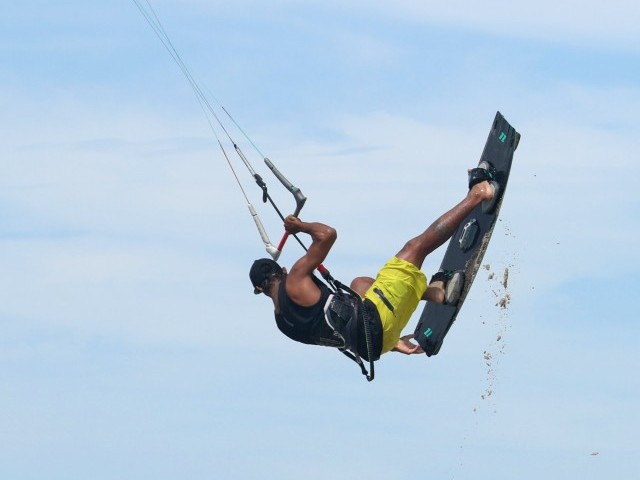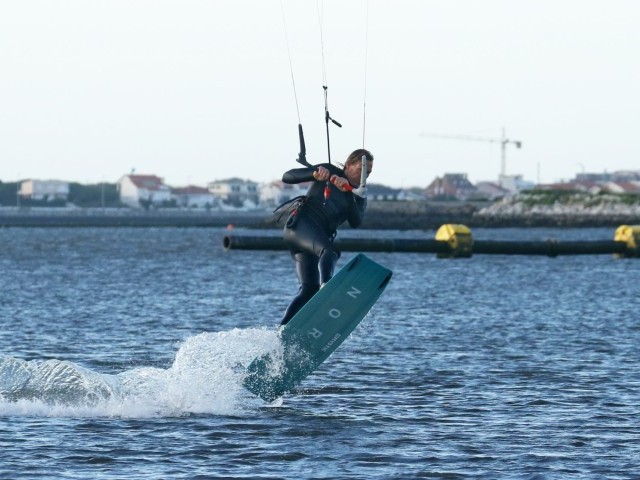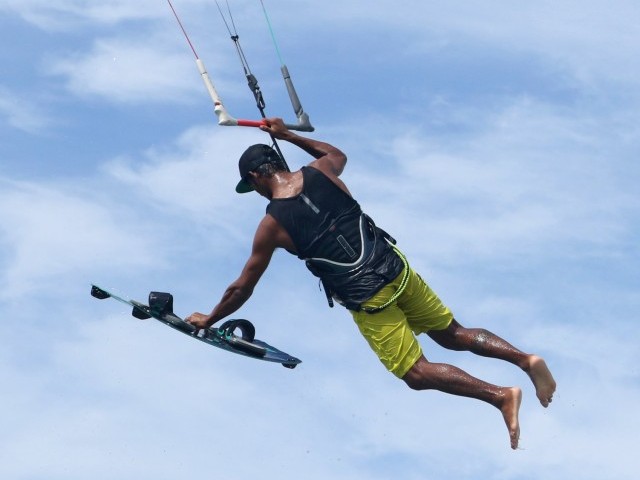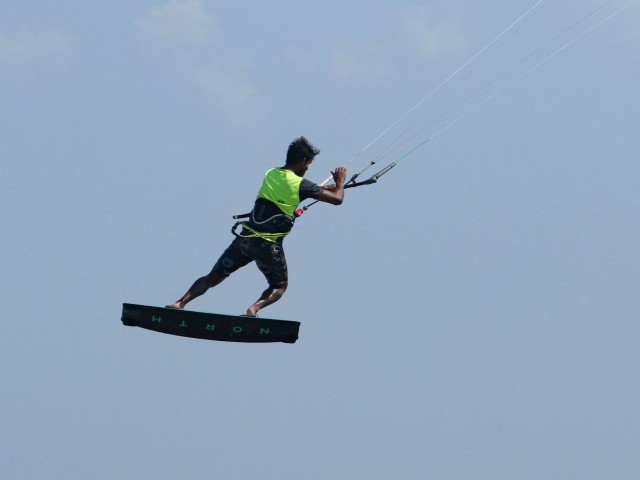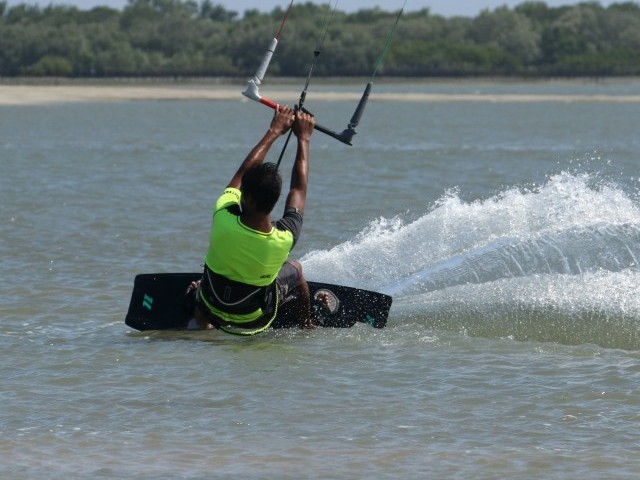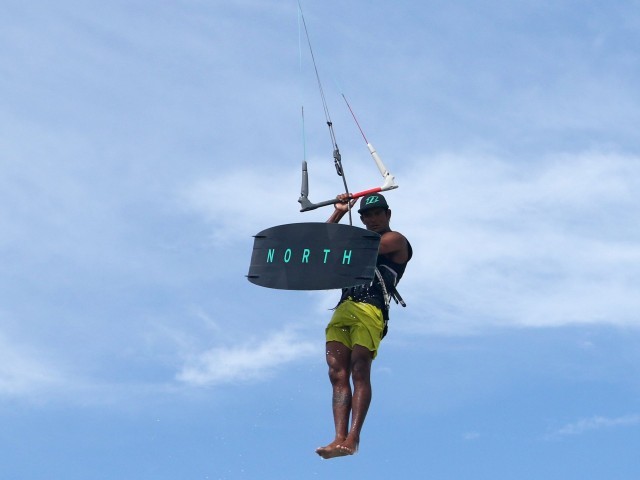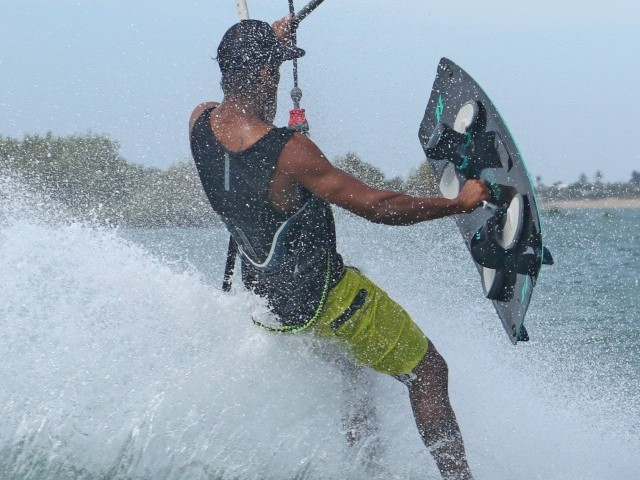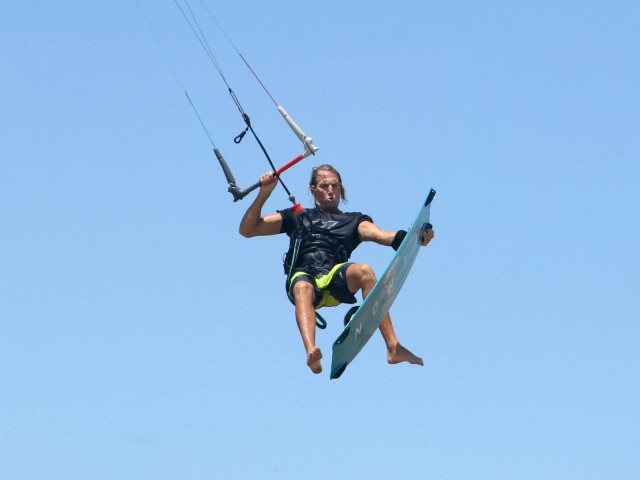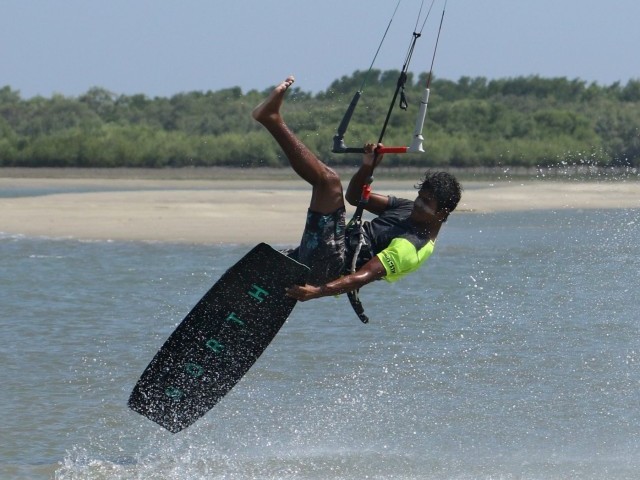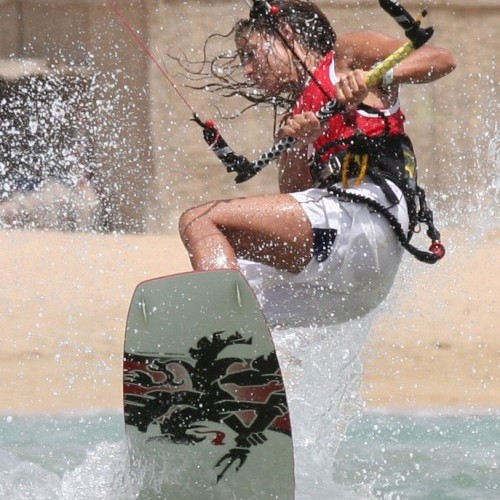
Raley to Blind with Surface Pass
Technique / Advanced
Introduction
This is a killer combo! As far as non-big air tricks go, landing an unhooked move to blind and surface passing out of it is the shizzle. What’s more, once you can throw it to blind like Andre Phillip, it’s just another way to land any trick, and a rocking way to build up to powered passes. The cherry on top of the icing, on the rather large cake is that this is another move that can be learnt and practiced in marginal conditions, so bring on the summer breezes (please)!
The best way to get your head around blind to pass moves is the somewhat easier pop version. Once you’ve got this down, spicing it up to a Raley is a mater of water time. Just to get an idea of what a pop to blind with a surface pass is check out Karine in Video 2. Nice!
What’s the Crack?
As beautiful as these moves are, they do require a modicum of previously acquired skill. You can see from the sequence and the video that up to the landing at least, it appears that Karine could actually be going for some tasty blind riding. So not wanting to put anyone off, but here goes anyway, get your hooked in blind riding sorted first (see IKsurfmag issue 1). It will make the whole job so much easier, as you’ll already have a blind riding stance, the necessary pop and landing. In fact you’ll just need to be happy unhooking and taking off more downwind so that you can concentrate your energies on the bar pass.
Handy Work
Groundwork spent on dry land practicing your bar pass will produce dividends. Muscle memory is an undeniable truth, and if you’ve rehearsed well then hopefully you’ll banish the need for too much thought once you’re on the water. You will no doubt know which side you’ll ride blind, so work your hands out in relation to this. That is to say, if you are intending to pop to blind whilst riding towards your left (port tack) like Karine then first you’ll be letting go with your right (back) hand. If it’s to your right (starboard) then it’ll be your left hand.
In Video 1 Karine has a bar set up on dry land which will take her weight, but if you practise this on the beach before going out on the water, you can walk through it holding your bar.
Start with you hands centred and butted right up against the chicken loop line. You can see how as she lets go of the bar and turns her head and shoulders away, she is actually turning her leading hip towards the bar. Then as her back shoulder drops, she twists her wrist around, almost trying to point her thumb down. Once facing away from the bar Karine is bending over, her wrist has fully twisted around and the bar is horizontal. Her old back (right) hand has reached around behind her, and is grabbing the bar, palm facing up. Once Karine has hold of the bar, she lets go with her left hand (very important), continues to turn her head and shoulders to look in the direction in which she is travelling, and finally reaches for the bar again with her free hand.
Why?
On the water the only addition will be pulling the bar in hard with both hands before “throwing” the blind (Pic A). This brings the bar in close to the front hip, enabling an easier pass, as theoretically you could reach around and grab it. Also by pulling the bar in towards the front hip you will start to turn to blind.
By turning and dropping her shoulders and head into a bent over position, Karine keeps the bar close to her bottom, which yet again makes the bar easier to grab. If you think about it you can always tap your bum. If she was to stand bolt upright, her left arm would be pulled up, over and away from her shoulder. So without years of yoga and god given flexibility there is little hope of the other hand reaching up to grab the bar.
The wrist twist is undeniably important. Firstly by twisting your wrist you will be able to turn the shoulders, and therefore your whole self, further around. Secondly it places the bar in the perfect grabbing position, further around behind you, so the hand reaching around can find it easily. You could do everything else brilliantly, but if the bar is not waiting in the right place, there’s nothing to grab and it’s good night Vienna.
Grabbing the bar with your palm facing the sky yet again makes it easier to reach around further without the feeling of dislocation. It also is a must, following the original twist, so that you end up holding the bar correctly.
Letting go with the original bar hand, looking around towards the direction of travel and trying to get the free hand back on the bar is a fine idea, as hammering along, unhooked, glued in blind is not for the feint hearted (although it’s jolly good fun). By releasing the hand you can look around, stand up and regain your balance. The surface pass will inevitably lead to you riding toe side out of the move. If you have an obviously better toe side, this is unlikely to be the one. Therefore it’s a good idea to slide the board around an extra 180 to get back onto heel side. Reaching around with your free hand will encourage this.
Downwind Pop
Now prior to executing this on the water lets have a quick ponder on what the board and kite are doing.
For your first attempts you really want to try and pop whilst travelling quite off the wind, 45 down from across the wind (broad reach) would be fantastic. The idea here is not to edge too hard but try and pop off a slightly flatter board, harder edging is in the post, but be patient.
If you edge first and then head off on a broad reach, your kite will de-power for a short while, enabling you to start with the bar in close, as the lines will be slightly slacker, giving you more chance of passing the bar.
Also if you take off more downwind, you do not have as far to turn the board. Your aim is to land more off the wind than you would for hooked in blind riding. If you land flat going towards the kite you have time to pass. If you land on an edge, you’ll tension the lines and splash.
To keep the bar close to you, and reduce power in the kite it’s a good plan to start this with the kite around 10:30 or 1:30. Any higher and the kite will pull the bar up, making for a contortionist’s pass.
Finally make sure you leash is on the correct side. It should be hanging in front of you, so port tack on your left and starboard on your right. Once you nail one or get close, in your excitement it’s easy to forget to swap the leash around again. You’ll just end up in knots.
Following Sequence 1
- Pic 1. Flattening the board and heading off the wind Karine pulls the bar into her hips to unhook. She keeps her shoulders back and hips up which keeps her balanced and stops her getting pulled over the board.
- Pic 2. Karine pushes the bar down to release the chicken loop.
- Pic 3. Unhooked, Karine moves her weight back by shifting her hips towards her back (right) foot.
- Pic 4. Karine drops her weight by bending her knees (you will not carve hard whilst learning this move).
- Pic 5. She “pops” upwards, edging only gently, and already starts to pull the par in towards her.
- Pic 6. As Karine comes up off the water she “throws” herself to blind, just as she would hooked in.
- Pic 7. Bending at the waist, you can she how the bar is right into Karine’s front hip, her trailing shoulder is dropping and she is about to release her back (right) hand as the bar starts to twist.
- Pic 8. Karine has released the bar to turn her shoulders further and the wrist is twisting the bar around. The kite will now steer slowly down.
- Pic 9. Landing off the wind Karine has twisted the bar around and her released hand is on its way round in quest to find the bar.
- Pic 10. By almost kissing the water Karine keeps the bar near her derriere, and reaches up with her free hand.
- Pic 11. With no edge in the water Karine catches the bar up, and grabs it with searching hand.
- Pic 12. Letting go with her original front hand, Karine turns to look where she is going.
- Pic 13. With her weight still on her trailing foot (it has been since landing), Karine leans on her heels to turn the board downwind. Now that she is holding the bar with her backhand the kite will steer back up.
- Pic 14. Karine reaches around with her right hand, keeping her weight on her heels, so as not to catch her toe side edge. As the board comes around she will move her hips over her new back (right) foot, scream loudly and sail away.
Alternatively if you are happy riding toe side on exit you could pop back to heel side, or wait for the kite to rise, keep pulling on you back hand and follow it around for a heel side carve.
Raley to Blind
Once you mastered the pop to blind, by adding more speed, more power, more edge and therefore more pop you will evolve this move into a fully blown Raley to blind as shown in Video 3.
Seeing as how the principles are the same you can read the following as true regardless whether you are trying a more aggressive pop to blind or a fully stretched out Raley to blind. We do suggest that if you fancy the Raley to blind, yet again getting your raleys fully dialled before adding any blindness will help no end.
Following Sequence 2
In the video you can see that this move is started with speed across the wind, regardless of power and the kite positioned at 1:30, to keep the bar low and near the hips.
- Pic 1. Yet again bearing off the wind to increase speed and reduce the tension in the lines to unhook. Also remember from “popping” (this issue), how the kite will drop back in the window as you head more downwind. This will stop you turning too far into wind when you edge, and pull you further downwind for your landing, which will give you slack time to pass the bar. In the video the downwind time is very short as unhooking and turning off the wind are done at the same time. When learning don’t rush this stage as the approach is everything.
- Pic 2. With the bar pushed down to release the chicken loop Christian moves his hips back over his back foot, straightening the front leg, ready to edge like a banshee.
- Pic 3. Kite face-tastic. With eyeballs popping, teeth grinding, and vanity thrown to the wind Christian drops low against the power and suddenly carves exceptionally hard away from the kite as if his life depends on it.
- Pic 4. As Christian looses his battle of tug and war against the kite he keeps his front leg straight, which keeps the board hard on it’s edge, and really explodes against his back foot by fiercely extending his back leg in a final effort to get as much tension in the lines as possible. Still not pretty.
- Pic 5. Christian is forced off the water as the kite pulls him up, over and off downwind, extending his body.
- Pic 6. Here Christian has realised he’s moments from landing. In preparation for a blind reception he is already concentrating on his potential landing spot. This needs to be done early, as shortly he’ll be turning his back on it. Christian has pulled the bar in and under his shoulders towards his hips and is pulling his knees in to help with the rotation. Once in the Raley position timing is everything. Don’t try and throw yourself aimlessly to blind, you’ll need to wait until almost the last minute, before starting your body rotation. This way you will not be pulling against power, but against slackening lines which will enable you to get the bar in close. If you feel that the kite is rising, now is the time to pull a bit on the front hand to get it down a notch or two, as this will let you get over the bar.
- Pic 7. All systems go. Christian turns his head away and pulls the bar down towards his leading (right) hip. This is the moment of full commitment. If you try and look where you are going you will prevent yourself from turning. After all it is only water.
- Pic 8. In order to keep turning Christian has released the bar with his back (left) hand. As he drops he will continue to turn his head and shoulders (even knees and toes).
- Pic 9. Due to heading off the wind before take off, and throwing hard, Christian is landing with the board off the wind, so no chance of catching his heel side edge. He’s looking around with his head and twisting his wrist to turn the bar and at the same time dropping his head and shoulders, bending over so that the bar will near his bottom.
- Pic 10. Pass time. The wrist has twisted the bar around, Christian is bent over and the board is heading off the wind. You can just see the resulting slack in the visible line. This makes it easy for him to reach around and grab the bar.
- Pic 11. Letting go with his original front hand Christian carves onto his heels and looks around.
- Pics 12 to 15. Christian slides the board through 180 and reaches forwards for the bar with his free hand, keeping his heel side dug in and then moving his weight over his new back foot.
- Pic 16. Now fully comfy and all back to normal Christian grabs the bar, hooks back in and rides on.
Top Tips
For all unhooked blind moves that you intend to pass out of, you will need to turn the board much further when going to blind than you are used to when hooked in.
To visualise this imagine that although you pull to the front hip, you continue to rotate. So when you are passing the bar, you hand holding it has moved around behind you and will be resting on the other hip which will be facing downwind when you land.
Really do go downwind before edging – it’s a must for all pop-induced and bar pass tricks.
When you pull the bar in hard before rotating, make sure to pull hard on the front hand so the kite doesn’t rise. Especially important if you back hand is your stronger one (right hander popping to port).
Don’t get stuck in blind. Make a point of swinging your free arm around and looking around with your head.
This technique article was in Issue 4 of IKSURFMAG.
Related
By Christian and Karine
Christian and Karine have been working together as a coaching team, running improver to advanced kitesurfing clinics since 2003.







